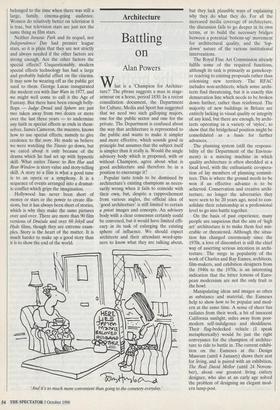Architecture
Battling on
Alan Powers
Popular taste tends to be dismissed by architecture's existing champions as neces- sarily wrong when it fails to coincide with their own, but, despite a rapprochement from various angles, the official idea of `good architecture' is still limited to certain a priori images and concepts. An advisory body with a clear consensus certainly could be convened, but it would have limited effi- cacy in its task of enlarging the existing sphere of influence. We should expect architects and their attendant word-spin- ners to know what they are talking about, but they lack plausible ways of explaining why they do what they do. For all the increased media coverage of architecture, the discussion fails to go deeper in its own terms, or to build the necessary bridges between a potential 'bottom-up' movement for architectural quality, and the 'top- down' nature of the various institutional interventions.
The Royal Fine Art Commission already fulfils some of the required functions, although its task is primarily as gamekeep- er reacting to existing proposals rather than colonising new territory. The RFAC includes non-architects, which some archi- tects find threatening, but it is exactly this demarcation line which needs to be broken down further, rather than reinforced. The majority of new buildings in Britain are entirely lacking in visual quality or integrity of any kind, but there are enough, by archi- tects operating in a variety of 'styles', to show that the bridgehead position might be consolidated as a basis for further advances.
The planning system (still the responsi- bility of the Department of the Environ- ment) is a mincing machine in which quality architecture is often shredded at a local level, with the enthusiastic co-opera- tion of lay members of planning commit- tees. This is where the ground needs to be won if an effective advance is to be achieved. Conservation and creative archi- tecture, no longer the adversaries they were seen to be 20 years ago, need to con- solidate their relationship at a professional level to go into battle together.
On the basis of past experience, many people are suspicious that the aim of 'high art' architecture is to make them feel mis- erable or threatened. Although the situa- tion has changed enormously since the 1970s, a love of discomfort is still the chief way of asserting serious intention in archi- tecture. The surge in popularity of the work of Charles and Ray Eames, architects, film-makers, and exhibition designers from the 1940s to the 1970s, is an interesting indication that the bitter lemons of Euro- pean modernism are not the only fruit in the bowl.
Manipulating ideas and images as often as substance and material, the Eameses help to show how to be popular and mod- em at the same time. A sense of sheer fun radiates from their work, a bit of innocent California sunlight, miles away from post- modern self-indulgence and shoddiness. Their flag-bedecked vehicle (I speak metaphorically) would be just the right conveyance for the champion of architec- ture to ride to battle in. The current exhibi- tion on the Eameses at the Design Museum (until 4 January) shows their zest for living, and is paired with an exhibition, The Real David Mellor (until 24 Novem- ber), about our greatest living cutlery designer, who also at an early age solved the problem of designing an elegant mod- ern lamp-post.










































































 Previous page
Previous page